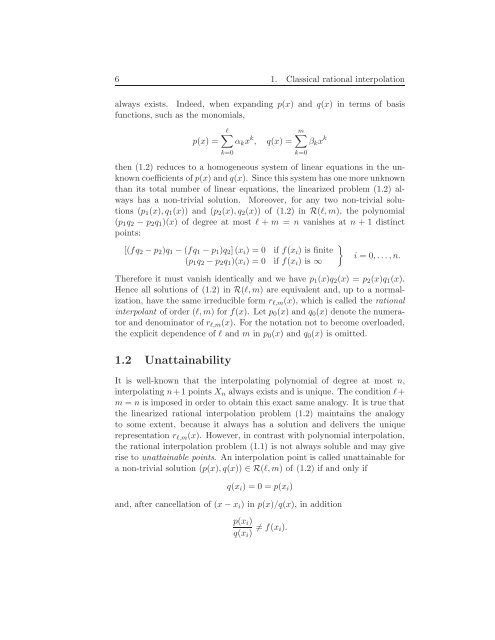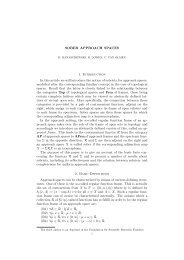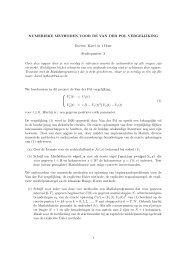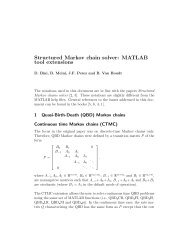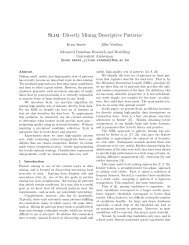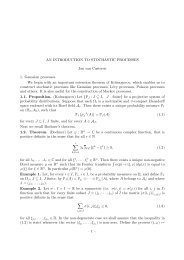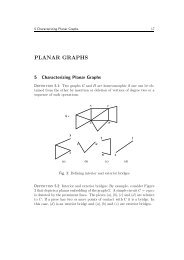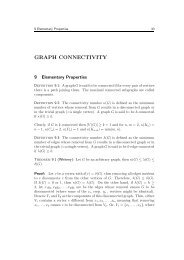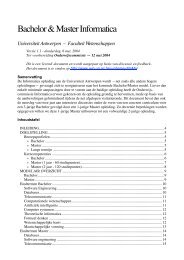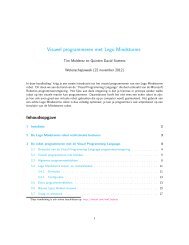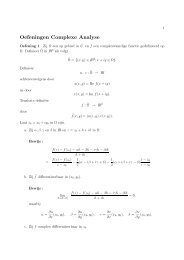Practical Rational Interpolation of Exact and Inexact Data Theory ...
Practical Rational Interpolation of Exact and Inexact Data Theory ...
Practical Rational Interpolation of Exact and Inexact Data Theory ...
You also want an ePaper? Increase the reach of your titles
YUMPU automatically turns print PDFs into web optimized ePapers that Google loves.
6 1. Classical rational interpolation<br />
always exists. Indeed, when exp<strong>and</strong>ing p(x) <strong>and</strong> q(x) in terms <strong>of</strong> basis<br />
functions, such as the monomials,<br />
p(x) =<br />
ℓ<br />
αkx k , q(x) =<br />
k=0<br />
m<br />
k=0<br />
βkx k<br />
then (1.2) reduces to a homogeneous system <strong>of</strong> linear equations in the unknown<br />
coefficients <strong>of</strong> p(x) <strong>and</strong> q(x). Since this system has one more unknown<br />
than its total number <strong>of</strong> linear equations, the linearized problem (1.2) always<br />
has a non-trivial solution. Moreover, for any two non-trivial solutions<br />
(p1(x),q1(x)) <strong>and</strong> (p2(x),q2(x)) <strong>of</strong> (1.2) in R(ℓ,m), the polynomial<br />
(p1q2 − p2q1)(x) <strong>of</strong> degree at most ℓ + m = n vanishes at n + 1 distinct<br />
points:<br />
[(fq2 − p2)q1 − (fq1 − p1)q2] (xi) = 0 if f(xi) is finite<br />
(p1q2 − p2q1)(xi) = 0 if f(xi) is ∞<br />
<br />
i = 0,... ,n.<br />
Therefore it must vanish identically <strong>and</strong> we have p1(x)q2(x) = p2(x)q1(x).<br />
Hence all solutions <strong>of</strong> (1.2) in R(ℓ,m) are equivalent <strong>and</strong>, up to a normalization,<br />
have the same irreducible form rℓ,m(x), which is called the rational<br />
interpolant <strong>of</strong> order (ℓ,m) for f(x). Let p0(x) <strong>and</strong> q0(x) denote the numerator<br />
<strong>and</strong> denominator <strong>of</strong> rℓ,m(x). For the notation not to become overloaded,<br />
the explicit dependence <strong>of</strong> ℓ <strong>and</strong> m in p0(x) <strong>and</strong> q0(x) is omitted.<br />
1.2 Unattainability<br />
It is well-known that the interpolating polynomial <strong>of</strong> degree at most n,<br />
interpolating n+1 points Xn always exists <strong>and</strong> is unique. The condition ℓ+<br />
m = n is imposed in order to obtain this exact same analogy. It is true that<br />
the linearized rational interpolation problem (1.2) maintains the analogy<br />
to some extent, because it always has a solution <strong>and</strong> delivers the unique<br />
representation rℓ,m(x). However, in contrast with polynomial interpolation,<br />
the rational interpolation problem (1.1) is not always soluble <strong>and</strong> may give<br />
rise to unattainable points. An interpolation point is called unattainable for<br />
a non-trivial solution (p(x),q(x)) ∈ R(ℓ,m) <strong>of</strong> (1.2) if <strong>and</strong> only if<br />
q(xi) = 0 = p(xi)<br />
<strong>and</strong>, after cancellation <strong>of</strong> (x − xi) in p(x)/q(x), in addition<br />
p(xi)<br />
= f(xi).<br />
q(xi)


